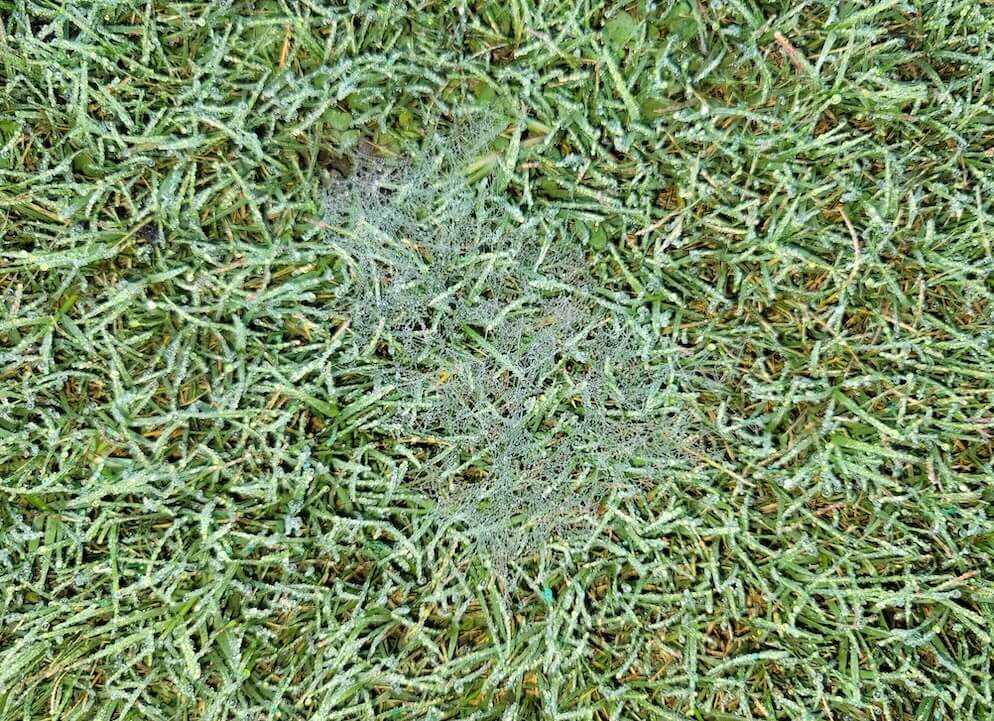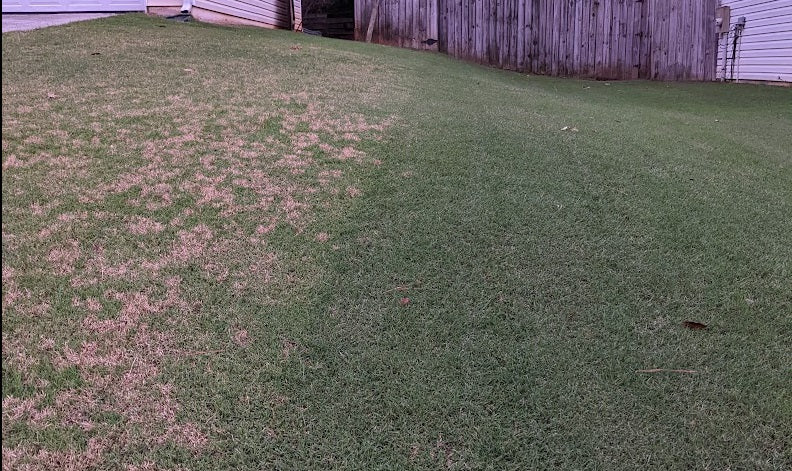How to Prevent and Control Dollar Spot
As the winter frost melts away and spring emerges, we eagerly anticipate the lush green carpet that blankets our lawns. However, this season also brings with it the risk of various lawn diseases and fungi that can mar the beauty of outdoor space.
One of the most problematic lawn fungi is dollar spot. Caused by fungal pathogens, it manifests as small, round patches on the lawn resembling silver dollars — hence the name. While it may seem daunting, preventing and treating dollar spot is possible with the proper knowledge and a proactive approach to lawn care.
Why Is Dollar Spot Attacking Your Lawn?
Dollar spot is primarily caused by fungi from the genus Clarireedia jacksonii. It can be triggered by a combination of factors, including prolonged periods of high humidity, excess moisture, and nitrogen deficiency in the soil. Recognizing the symptoms early is crucial for effective management. Dollar spot is most active between 50 and 95°F, with severe pathogenicity observed between 59 and 77°F.
What Type of Turf Is Most Likely to Get Dollar Spot?
Dollar spot is a fungal disease that can affect various turfgrass species, but some grass types are more susceptible than others. The severity of dollar spot can depend on factors such as environmental conditions, cultural practices, and the specific grass varieties present in the lawn. Generally, certain turfgrass species are more prone to dollar spot than others. Here are some grass types that are commonly susceptible:
Warm-Season Grasses
St. Augustine Grass
St. Augustine grass is known to be more susceptible to dollar spot compared to some other warm-season grasses. It can be prone to diseases in humid conditions.
Centipede Grass
Centipede grass is often considered more susceptible to dollar spot. It prefers acidic soils but may be more vulnerable in certain conditions.
Cool-Season Grasses
Annual Ryegrass
Annual ryegrass, commonly used for overseeding warm-season lawns, is more susceptible to dollar spot. Its rapid growth and lush foliage can make it prone to diseases.
Perennial Ryegrass
While perennial ryegrass is generally resistant to many diseases, it can be susceptible to dollar spot under certain conditions. It's essential to manage the lawn to minimize disease risk.
Bentgrass
Creeping bentgrass, often used on golf courses and fine turf areas, can be highly susceptible to dollar spot. It thrives in cool and humid conditions, creating an environment conducive to the disease.
Kentucky Bluegrass
While Kentucky bluegrass is mentioned in the resistant category as well, certain varieties or conditions may make it susceptible to dollar spot. It's crucial to choose disease-resistant cultivars and implement proper lawn care practices.
While these grass types are more prone to dollar spot, it's important to note the disease can still affect other turfgrass species under conducive conditions.
What Types of Grass Are Less Susceptible to Dollar Spot?
Warm-Season Grasses
Bermuda Grass
Bermuda grass is known for its excellent resistance to dollar spot. It's a warm-season grass that thrives in hot climates, providing a dense and resilient turf when properly maintained.
Zoysia Grass
Zoysia grass exhibits good resistance to dollar spot and other diseases. It forms a dense, carpet-like turf that can withstand various environmental stresses.
Buffalo Grass
Though not as commonly used as Bermuda or Zoysia, Buffalo grass is well adapted to warm climates and displays resistance to dollar spot.
Cool-Season Grasses
Fine Fescue Blend
Fine fescues — including varieties like creeping red fescue and chewings fescue — are often resistant to dollar spot. They thrive in cooler climates and shaded areas.
Tall Fescue
Tall fescue is known for its adaptability and resilience. It can tolerate a range of climates and exhibits good resistance to dollar spot.
Kentucky Bluegrass
Kentucky bluegrass performs well in regions with cold winters and moderate temperatures. It has a fine texture and is often included in premium lawn seed blends. But as mentioned above, it’s crucial to pick the right variety if your lawn is prone to dollar spot.
Related reading: Complete Guide to Identifying, Fighting and Preventing Lawn Diseases
Identifying This Lawn Menace

Initial Signs
Bleached Spots
The hallmark of dollar spot is the appearance of small, bleached spots on grass blades. These spots resemble straw-colored coins, typically not exceeding 2 inches in diameter, like an old silver dollar.
Localized Lesions
As the disease progresses, these initial spots can evolve into localized lesions on individual grass leaves. Lesions exhibit a characteristic hourglass shape, with a bleached white center and reddish-brown borders.
Lesion Characteristics
Close inspection of infected grass leaves reveals lesions with distinct features. The lesions often exhibit an hourglass shape, encircling the entire leaf blade. Older lesions may extend in length, causing blighting of the entire leaf or the cutting of leaf ends.
Color Changes
Initial symptoms involve small yellow-green chlorotic spots, gradually progressing into the more defined lesions. The evolution of these lesions contributes to the overall discoloration of the affected grass blades.
Patch Formation
In extensive dollar spot outbreaks, individual spots can merge, forming larger, irregular patches. Unlike some other turf diseases, the individual spots themselves do not dramatically increase in size, but their merging creates a visually impactful patchwork.
Mycelium Presence
Under certain conditions, particularly during hot days and warm nights with high humidity, dense aerial mycelium may appear on affected turf blades.
This mycelium is visible early in the morning and contributes to the disease's spread under conducive conditions. It looks like small spider webs on the lawn.

Related: Turf Wars: How to Treat Lawn Fungus
The Cost of Leaving Dollar Spot Untreated
Leaving dollar spot untreated in your lawn can have several negative consequences, both aesthetically and economically. Here are some potential costs associated with neglecting to address a dollar spot infestation:
1. Reduced Aesthetic Appeal
Dollar spot creates unsightly patches on your lawn, turning vibrant green grass into brown or straw-colored spots. These patches can significantly diminish the overall visual appeal of your lawn, affecting the beauty of your outdoor space
2. Weakened Turfgrass
The fungal pathogens responsible for dollar spot can weaken the affected turfgrass. Weakened grass is more susceptible to other diseases, pests, and environmental stressors, potentially leading to a decline in the overall health of your lawn.
3. Increased Lawn Maintenance Costs
To compensate for the damaged areas, you may need to invest more time and resources into lawn maintenance. This could include additional watering, fertilization, and overseeding to promote the recovery of affected areas.
4. Risk of Spreading to Other Areas
If left untreated, dollar spot can spread to other parts of your lawn. The disease can be easily transferred through mowing equipment, shoes, or other means, leading to a broader infestation and more extensive damage.
5. Need for Costly Fungicide Treatments
If the dollar spot becomes severe, addressing the issue may require the application of fungicides. Fungicides can be costly, and repeated applications may be necessary for effective control. Preventive measures are often more cost-effective than curative treatments.
6. Potential Lawn Renovation Costs
In extreme cases where dollar spot or other diseases have caused irreparable damage to the lawn, renovation or reseeding may be necessary. This can involve significant costs for purchasing new grass seed, soil amendments, and labor.
7. Impact on Property Value
A poorly maintained lawn can negatively impact the overall value of your property. Curb appeal plays a crucial role in property value, and a lawn riddled with diseases can detract from the attractiveness of your home.
5 Ways to Prevent Dollar Spot
1. Proper Lawn Maintenance
A well-maintained lawn is less susceptible to dollar spot fungus. Regular mowing at the appropriate height for your grass type helps maintain optimal air circulation and sunlight exposure. Additionally, avoid mowing more than one-third of the grass height at a time to prevent stress on the turf.
2. Adequate Watering
Dollar spot thrives in humid conditions, and overwatering can contribute to its development. Water your lawn deeply and infrequently, preferably early in the morning, to allow the grass to dry before evening. Use a soaker hose or irrigation system to ensure even water distribution and minimize moisture on the grass blades.
3. Proper Fertilization
Maintaining a balanced fertilization schedule is crucial for preventing dollar spot. Avoid excessive nitrogen, as it can make the grass more susceptible to fungal diseases. Instead, focus on slow-release fertilizers providing a steady nutrient supply without promoting rapid grass growth.
4. Core Aeration
Core aeration helps break up compacted soil and improve water and nutrient penetration. By reducing soil compaction, aeration creates a less favorable environment for dollar spot fungus. Perform aeration during the growing season to stimulate healthy grass growth.
5. Dethatching
Thatch buildup provides an ideal habitat for dollar spot fungus. Regular dethatching removes organic debris, allowing air and nutrients to reach the soil more efficiently. Consider dethatching your lawn annually, especially if you notice excessive thatch accumulation.
How to Treat Dollar Spot

Fungicides
When dollar spot has already infested your lawn, fungicides are an effective solution. Choose a fungicide specifically formulated for dollar spot control and apply it according to the manufacturer's instructions. Fungicides are most effective when used preventively or during the early stages of the disease.
Fungicide Recommendations for Dollar Spot
While cultural and biological methods are crucial components of a comprehensive dollar spot management strategy, there are instances where chemical control becomes necessary to mitigate the impact of this fungal disease. Choosing effective fungicides is key, and among the recommended options are Pillar® SC Fungicide and Headway® G Fungicide. Let's delve into their features and how they can contribute to a robust dollar spot control program.
1. Pillar® SC Fungicide — The Liquid Option
Product overview:
- Type: Liquid Fungicide
- Target diseases: Brown patch, dollar spot, plus a whole list more!
- Active ingredients: Triticonazole and Pyraclostrobin
Key features:
- Broad-spectrum control: Pillar® SC provides effective control not only against dollar spot but also brown patch and other turf diseases.
- Systemic action: The systemic nature of the active ingredients ensures thorough protection, penetrating the plant tissues and preventing fungal growth.
- Flexible application: Being a liquid formulation, Pillar® SC offers flexibility in application, allowing for precise and even coverage across the affected turf.
- Safe for all grass types
2. Headway® G Fungicide — The Granular Option
Product overview:
- Type: Granular Fungicide
- Target diseases: Dollar spot and various turf diseases
- Active ingredients: Azoxystrobin and Propiconazole
Key features:
- Dual-action formulation: Headway® G combines two active ingredients for a dual-action approach against dollar spot and a wide range of turf diseases.
- Granular format: The granular formulation simplifies application, making it convenient for homeowners and turf managers.
- Long-lasting protection: Headway® G provides extended protection, releasing the active ingredients gradually for sustained control.
Considerations for Fungicide Control:
Resistance management:
- Rotate fungicides with different modes of action to prevent the development of resistance.
- Avoid repetitive use of the same product to maintain its effectiveness.
- Follow environmental guidelines and local regulations when applying fungicides.
- Consider the persistence and safety of the chosen products in the soil.
Integrated approach:
- Combine chemical control with cultural, mechanical, and biological methods for a holistic dollar spot management strategy.
Related: The Most Effective Fungicides to Use on Your Lawn
Remember, before initiating any chemical control program, carefully read and adhere to the product labels for proper application, dosage, and safety guidelines.
Golf Course Lawn can help you prevent and eliminate invasive lawn fungi. Browse our range of highly effective insecticides and fungicides to get a healthy, vibrant lawn.
